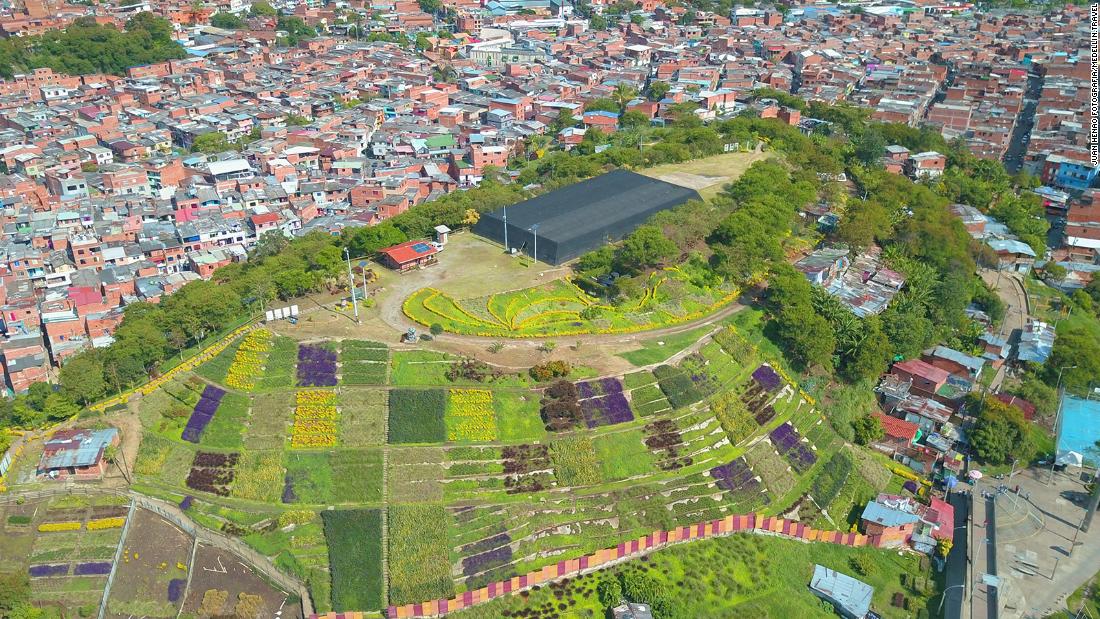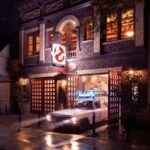
(CNN) — It truly is a sunny afternoon in Moravia, and persons are busy weeding the communal gardens on prime of El Morro de Moravia (Moravia Hill), which sits at the heart of this operating-class Medellín neighborhood.
Other folks are in the greenhouse, inspecting orchids in myriad tropical shades and rows of bromeliads, whose glossy orange bracts erupt from waxy leaves.
Outside, kids fly kites, the flimsy colored plastic shuddering in the gusts that blast and swell, just before leaping up into cerulean skies. All around them are families, assembly to chat and get pleasure from the panoramas of Medellín that this vantage level, 35 meters (115 feet) above the community, grants.
Concrete ways stamped with words and phrases these kinds of as “dignity” and “big difference” lead up to the hilltop and are bordered by black and white photos of this tranquil park in its former — and fully sudden — incarnation.
Like the relaxation of the metropolis — which was dubbed the world’s most perilous by Time journal in 1988 — it really is unrecognizable. After all, beneath everyone’s feet lies a decade’s value of rubbish and what was when the municipal landfill.
El Morro landfill formally shut in 1984, and desperate families started to make their homes on major.
Courtesy Medellín.Vacation
‘A dark corner of the city where nobody dared to go’
A lot of discovered their way to Moravia, an casual neighborhood that at the time lay on the outskirts of Medellín.
In the 1970s as the city expanded, the regional authorities specified Moravia as the site of the new municipal landfill. Existing inhabitants ended up relocated to distant places in the west of Medellín individuals who remained — dubbing themselves “The Resistance” — confronted the realities of dwelling beside a rubbish heap.
A lot of turned to recycling as a signifies of etching out an existence. Each working day, 1 hundred tons of squander — about the excess weight of a Boeing 757-200 — was dumped onto the site.
When the landfill was formally shut in 1984, determined family members — numerous with youthful young children — commenced to construct their homes on leading. Above the subsequent 20 a long time, the inhabitants of El Morro swelled to more than 15,000, all dwelling in precariously created shacks manufactured from whichever they could scavenge.

The hill was protected around and is now a flourishing urban park and backyard garden.
Juan Henao Fotografia/Medellín.Vacation
“The very first home that I built was made of cardboard, plastic and picket poles,” describes Elsy Torreglosa Gallego, who arrived in 1986, 4 kids in tow. Ailments were being unsanitary, and the hazard of hearth frequent for the reason that of cramped housing constructed from flammable materials and the noxious cloud of toxic gases that bubbled up from the squander.
A additional instant issue, nevertheless, was violence.
In the 1980s and 1990s, Medellín was in the grip of a bloody struggle among medication cartels, the most notorious of which was led by Pablo Escobar. In Moravia, rival gangs and armed teams recruited from the ranks of youthful people today.
Moravia speedily became a no-go zone for the rest of the metropolis, with citizens dealing with the stigma of dwelling in such a dangerous put.
“Moravia was a dim corner of the metropolis wherever no one dared to go. When we experimented with to get jobs in other pieces of the metropolis, they would say ‘no, due to the fact you might be from Moravia’. We experienced to lie in buy to get get the job done,” recollects Gallego.
Flowers bloom from trash
All the things changed in 2004.
Believing that lifestyle could be various, group leaders commenced “knocking on doors: the government’s, organizations, anybody who would be eager to assistance us fix the wants of the community,” states Gloria Ospima, who moved to Moravia with her relatives in 1968 at age 6, and is now one of the area’s additional than 100 mostly female local community leaders.
These requests had been satisfied with motion when the government declared the Moravia Integral Improvement program, which commenced clearing slums from the rubbish mountain and changing it — in component by masking the rubbish heap with filth — into a 30,000-sq.-meter urban park.
The government also invested in new neighborhood structures. As element of this tactic, residents residing beside El Morro had been also authorized to lawfully buy their land and properties.
“Those people 15 minutes when the mayor advised us that they were being going to concentration on Moravia and help us was lifetime-transforming,” recollects Gallego.

Bouquets to promote at fairs throughout the metropolis are grown in the extensive greenhouse at the top of El Morro.
Courtesy Medellín.Journey
Nowadays, the neighborhood couldn’t look extra different.
Gallego is component of Cojardicom, a collective of females who carefully are inclined the flower beds that now line the slopes of El Morro, which prosper with coloured grasses and extra than 70 species of plants. In the large greenhouse located at the pretty top, they also grow flowers to offer at fairs throughout the metropolis, in a single of the most symbolic functions of transformation: making bouquets bloom from trash.
Lively community existence
Back beneath the hill, Moravia thrives, much too.
A person of the most densely populated neighborhoods in the town, it is really a jumble of concrete and brick dwellings that increase up like upside-down pyramids as every new tale is greater than the past, and whose partitions are a flush of shade from avenue artwork that pays homage to revered group leaders who’ve spearheaded Moravia’s metamorphosis.

Murals, this kind of as this just one by Jefa, bring flushes of coloration to a lot of partitions in Moravia.
Courtesy Medellín.Travel
Dotted in among are little dining places serving freshly squeezed fruit juices and deep-fried, cheese-filled buñuelos, whose aromas settle into air stuffed with the buzz of mopeds careering as a result of narrow streets. IA smattering of present stores has sprung up offering regionally handcrafted jewelery and giving considerably-essential sources of income to residents.
If El Morro is the inexperienced lung of the neighborhood, this is its beating heart.
Seventeen paid personnel and an military of volunteers give cultural and academic plans, with all the things from ballet to breakdancing and woodwork to weaving, whilst local artists and theater groups can show and conduct their get the job done.
Ana Maria Restrepo, standard coordinator at the middle, is under no illusions as to the scale of its affect on area persons.
“We know that art and culture are platforms that help individuals to link, and that link transforms into a knowledge of the globe,” she enthuses. “A different perspective of the world alterations every little thing for people here who traditionally have not experienced a lot of possibilities.”

Excursions offer website visitors a opportunity to check out the area’s transformation.
Courtesy Medellín.Journey
A long term that hangs in the stability
But, just after around a ten years of sustained enhancements, a new system for the neighborhood threatens its existence.
Issued in 2018, the Prepare Parcial de Renovación Moravia (Moravia Partial Renovation Plan) proposes converting 50 % of the region into a general public park, although a further more quarter of present dwellings would be changed with 20 higher-rise apartment blocks — a prepare that critics argue will relocate a 3rd of inhabitants and improve the social make up of the spot.
One these kinds of critic is Maximilian Becker, co-founder of architecture collective Oasis Urbano, which, considering that 2016, has worked with community leaders to empower the neighborhood in an “solution that places local communities at the heart of the approach, bridging the hole between top-down and bottom-up organizing,” Becker points out.
These multistory apartments, he argues, will have “no infrastructure, no searching, no culture, no very little. It truly is the complete opposite of Moravia.”
But the continual threat of relocation isn’t really the only disabling drive inhabitants should encounter.
Around the past number of months, an believed 1,000 new shanty dwellings have sprung up after far more on El Morro, with group leaders blaming a wave of Venezuelan refugees and governing administration inaction.
The future of the undertaking now hangs in the stability.
“We have experienced a setback of far more or less 20 several years,” Gallegos argues, reflecting the palpable anger from citizens and local community leaders, who see the governing administration as obtaining failed in their responsibility to avert households from repopulating the hill.

A see from the major of El Morro appears across Rio Medellín and the tram station.
Courtesy Medellín.Journey
Conquering stigma and having a voice
New jobs continue on even with this uncertainty.
Oasis Urbano and local community leaders are working to build Taller Tropical 2., the second variation of a bamboo-developed open-air workshop that hosted 10,000 men and women for cooking courses, concert events, workshops and additional around a few several years, but was deconstructed previously this calendar year when the lease ran out.
Working with crowdfunding, they prepare to rebuild and extend the creating to turn into a 4-floor group hub, encompassing a cooking faculty, restaurant and neighborhood kitchen area, workshop areas and a library.
Pursuing the election of a new mayor in 2019, people are also optimistic that there is considerably less of an appetite to enact the controversial relocation designs. As a substitute, you can find hope that conversations amongst govt and neighborhood individuals can inspire a rethink, enabling the neighborhood who have fought so challenging for Moravia to be provided a voice, too.
If vacationers carry on to pay a visit to and listen to the neighborhood’s exceptional tale of hope, group toughness and transformation, it might also support assure the longevity of the improvements.
Overcoming the stigmas that inhabitants nevertheless experience from other Colombians who, in contrast to worldwide visitors, continue to be fearful of coming into the community is an critical section of this.
“Moravia was a place no one needed to appear to. There was violence, it smelled bad and there have been loads of mosquitoes,” Ospima explains.
“But these days, people from other countries arrive and are interested in listening to and being aware of our history. This demonstrates what we have reached in this community, and our ability to improve and renovate.”





